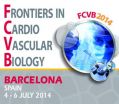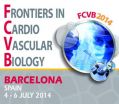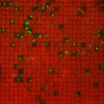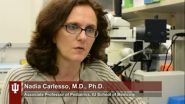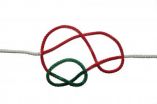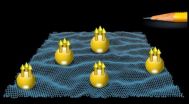(Press-News.org) This news release is available in Spanish.
Barcelona, 4 July 2014: An association between high blood cholesterol and breast cancer has been found in a study of more than 1 million patients over a 14 year time period in the UK. The research will be presented today at Frontiers in CardioVascular Biology (FCVB) 2014 in Barcelona, Spain. The meeting is organised by the Council on Basic Cardiovascular Science of the European Society of Cardiology (ESC) in collaboration with 13 European cardiovascular science societies.
http://spo.escardio.org/SessionDetails.aspx?eevtid=65&sessId=13301&subSessId=3494
Dr Rahul Potluri, founder of the ACALM Study Unit and lead author, said: "Our preliminary study suggests that women with high cholesterol in their blood may be at greater risk of getting breast cancer. It raises the possibility of preventing breast cancer with statins, which lower cholesterol, but as this is a primitive study, significant time and research is needed before this idea can be tested."
Over the past few years, population studies have suggested an association between obesity and breast cancer. Last year a study in mice concluded that lowering circulating cholesterol or interfering with its metabolism may be used to prevent or treat breast cancer.1
Dr Potluri said: "We have a general principle that obesity is linked to breast cancer and a study in mice suggested that this may be because of cholesterol. We decided to investigate whether there was any association between hyperlipidaemia, which is high cholesterol essentially, and breast cancer."
The researchers conducted a retrospective analysis of more than 1 million patients across the UK between 2000 and 2013 from the Algorithm for Comorbidities, Associations, Length of stay and Mortality (ACALM) clinical database. There were 664,159 women and of these, 22 938 had hyperlipidaemia and 9 312 had breast cancer. Some 530 women with hyperlipidaemia developed breast cancer.
The researchers used a statistical model to study the association between hyperlipidaemia and breast cancer. They found that having hyperlipidaemia increased the risk of breast cancer by 1.64 times (95% confidence interval 1.50-1.79).
Dr Potluri said: "We found that women with high cholesterol had a significantly greater chance of developing breast cancer. This was an observational study so we can't conclude that high cholesterol causes breast cancer but the strength of this association warrants further investigation."
He added: "A prospective study that monitors the risk of breast cancer in women with and without high cholesterol is needed to confirm what we observed. If the connection between high cholesterol and breast cancer is validated, the next step would be to see if lowering cholesterol with statins can reduce the risk of developing cancer."
Dr Potluri continued: "Statins are cheap, widely available and relatively safe. We are potentially heading towards a clinical trial in 10-15 years to test the effect of statins on the incidence of breast cancer. If such a trial is successful, statins may have a role in the prevention of breast cancer especially in high risk groups, such as women with high cholesterol."
He concluded: "While our study was preliminary, our results are promising. We found a significant association between having high cholesterol and developing breast cancer that needs to be explored in more depth. Caution is needed when interpreting our results because while we had a large study population, our analysis was retrospective and observational with inherent limitations. That said, the findings are exciting and further research in this field may have a big impact on patients several years down the line.'
Please note Spanish version is available for this Press Release
Reference
1Nelson ER, Wardell SE, Jasper JS, Park S, Suchindran S, Howe MK, Carver NJ, Pillai RV, Sullivan PM, Sondhi V, Umetani M, Geradts J, McDonnell DP. 27-Hydroxycholesterol links hypercholesterolemia and breast cancer pathophysiology. Science. 2013 Nov 29;342(6162):1094-8. doi:10.1126/science.1241908.
Did you want to tweet about our congress? - if you do, please use the official #FCVBCongress hashtag! Thank you
Note to Editors
About FCVB
Frontiers in CardioVascular Biology (FCVB) is a comprehensive basic science conference organised every two years by the ESC Council on Basic Cardiovascular Science, whose mission is to enhance the importance of basic science to clinical cardiology. FCVB 2014 was organised in collaboration with 13 European cardiovascular science societies.
About the European Society of Cardiology (ESC)
The European Society of Cardiology (ESC) represents more than 80 000 cardiology professionals across Europe and the Mediterranean. Its mission is to reduce the burden of cardiovascular disease in Europe.
Information for journalists attending FCVB 2014
If you have any question or request regarding interview opportunities, please contact:
ESC Press Office - Alice Prieto
press@escardio.org
Tel: +336 22 41 84 92 (off site support number)
FCVB 2014 takes place in Barcelona, Spain, on 4 – 6 July 2014 at the Palau de Congressos de Catalunya.
Please note that this year the ESC Congress 2014 will also take place in Barcelona, at FIRA Gran Via from 30 August – 3 September 2014. http://www.escardio.org/congresses/esc-2014/Pages/welcome.aspx
You can already register on-line as press: http://www.escardio.org/congresses/esc-2014/registration/Pages/press-registration.aspx
Look here for the current programme at a glance:
http://www.escardio.org/congresses/frontiers-in-cardiovascular-biology-2014/Documents/programme-at-a-glance.pdf
For full details of a session, have a look at the Scientific Programme & Planner:
http://spo.escardio.org/default.aspx?eevtid=65
On-site Press registration process:
o Free registration applies to press representatives upon receipt of valid credentials and a fully completed embargo form.
o Credential: either your ID press card or letter of assignment with proof of 3 published articles
o Press registration is not available to Industry or its Public Relations representatives, event management, marketing or communications representatives
o The decision of the ESC Press Office is final regarding all press registration requests.
o When your registration as press will be validated you will be given a press badge and the press kit.
INFORMATION:
Contact: ESC Press Office
Alice Prieto
press@escardio.org
Tel: +336 22 41 84 92
European Society of Cardiology
Association found between high cholesterol and breast cancer
Findings raise the possibility of preventing breast cancer with statins
2014-07-04
ELSE PRESS RELEASES FROM THIS DATE:
First evidence for painless atrial fibrillation treatment
2014-07-04
Barcelona, 4 July 2014: The first evidence for a shockless treatment for atrial fibrillation (AF) will be presented today at Frontiers in CardioVascular Biology (FCVB) 2014 in Barcelona, Spain. The meeting is organised by the Council on Basic Cardiovascular Science of the European Society of Cardiology (ESC) in collaboration with 13 European cardiovascular science societies. http://spo.escardio.org/SessionDetails.aspx?eevtid=65&sessId=13104
Dr Brian O. Bingen, first author, said: "AF is the most common cardiac arrhythmia. Symptoms range from the feeling of fish flapping ...
Effects of conflict on women's reproductive health need to be managed sensitively
2014-07-04
Clinicians need to be sensitive and aware of the unique challenges of women's reproductive health needs in times of conflict, suggests a new review published today (4 July) in The Obstetrician & Gynaecologist (TOG).
Approximately 1.5 billion people are currently living in countries affected by conflict, fragility or large-scale violence. Women and children account for approximately 75% of those displaced by conflict and roughly 20% of those displaced are women of reproductive age and one in five will be pregnant.
This new review looks at how conflict can negatively ...
New discovery in living cell signaling
2014-07-03
A breakthrough discovery into how living cells process and respond to chemical information could help advance the development of treatments for a large number of cancers and other cellular disorders that have been resistant to therapy. An international collaboration of researchers, led by scientists with the U.S. Department of Energy (DOE)'s Lawrence Berkeley National Laboratory (Berkeley Lab) and the University of California (UC) Berkeley, have unlocked the secret behind the activation of the Ras family of proteins, one of the most important components of cellular signaling ...
Compounded outcomes associated with comorbid Alzheimer's disease & cerebrovascular disease
2014-07-03
LEXINGTON, Ky. (July 3, 2014) -- Researchers from the Sanders-Brown Center on Aging at the University of Kentucky have been able to confirm anecdotal information on patients with both Alzheimer's disease (AD) and cerebrovascular disease (CVD) using mouse models in two different studies.
The findings of these two studies, which were recently published in Acta Neuropathologica and Alzheimer's Research & Therapy, have potentially significant implications for patients with both disorders.
Both papers studied CVD in Alzheimer's disease mouse models using different lifestyle ...
Biochemical cascade causes bone marrow inflammation, leading to serious blood disorders
2014-07-03
VIDEO:
Like a line of falling dominos, a cascade of molecular events in the bone marrow produces high levels of inflammation that disrupt normal blood formation and lead to potentially deadly...
Click here for more information.
INDIANAPOLIS -- Like a line of falling dominos, a cascade of molecular events in the bone marrow produces high levels of inflammation that disrupt normal blood formation and lead to potentially deadly disorders including leukemia, an Indiana University-led ...
How knots can swap positions on a DNA strand
2014-07-03
Physicists of Johannes Gutenberg University Mainz (JGU) and the Graduate School of Excellence "Materials Science in Mainz" (MAINZ) have been able with the aid of computer simulations to confirm and explain a mechanism by which two knots on a DNA strand can interchange their positions. For this, one of the knots grows in size while the other diffuses along the contour of the former. Since there is only a small free energy barrier to swap, a significant number of crossing events have been observed in molecular dynamics simulations, i.e., there is a high probability of such ...
From pencil marks to quantum computers
2014-07-03
Introducing graphene
One of the hottest materials in condensed matter research today is graphene.
Graphene had an unlikely start: it began with researchers messing around with pencil marks on paper. Pencil "lead" is actually made of graphite, which is a soft crystal lattice made of nothing but carbon atoms. When pencils deposit that graphite on paper, the lattice is laid down in thin sheets. By pulling that lattice apart into thinner sheets – originally using Scotch tape – researchers discovered that they could make flakes of crystal just one atom thick.
The name ...
Payback time for soil carbon from pasture conversion to sugarcane production
2014-07-03
The reduction of soil carbon stock caused by the conversion of pasture areas into sugarcane plantations – a very common change in Brazil in recent years – may be offset within two or three years of cultivation.
The calculation appears in a study conducted by researchers at the Center for Nuclear Energy in Agriculture (CENA) of the University of São Paulo (USP) in collaboration with colleagues from the Luiz de Queiroz College of Agriculture (Esalq), also at USP. The study also included researchers from the Federal Institute of Alagoas (IFAL), the Brazilian Bioethanol Science ...
New satellite data like an ultrasound for baby stars
2014-07-03
An international team of researchers have been monitoring the "heartbeats" of baby stars to test theories of how the Sun was born 4.5 billion years ago.
In a paper published in Science magazine today, the team of 20 scientists describes how data from two space telescopes – the Canadian Space Agency's MOST satellite and the French CoRoT mission – have unveiled the internal structures and ages of young stars before they've even emerged as full-fledged stars.
"Think of it as ultrasound of stellar embryos," explains University of British Professor Jaymie Matthews, MOST ...
A young star's age can be gleamed from nothing but sound waves
2014-07-03
VIDEO:
In a young region like the so-called Christmas Tree Cluster, stars are still in the process of forming. A star is 'born' once it becomes optically visible (bottom right). During...
Click here for more information.
Determining the age of stars has long been a challenge for astronomers. In experiments published in the journal Science, researchers at KU Leuven's Institute for Astronomy show that 'infant' stars can be distinguished from 'adolescent' stars by measuring the acoustic ...
LAST 30 PRESS RELEASES:
University of Oklahoma researcher awarded funding to pursue AI-powered material design
Exploring how the visual system recovers following injury
Support for parents with infants at pediatric check-ups leads to better reading and math skills in elementary school
Kids’ behavioral health is a growing share of family health costs
Day & night: Cancer disrupts the brain’s natural rhythm
COVID-19 vaccination significantly reduces risk to pregnant women and baby
The role of vaccination in maternal and perinatal outcomes associated with COVID-19 in pregnancy
Mayo Clinic smartwatch system helps parents shorten and defuse children's severe tantrums early
Behavioral health spending spikes to 40% of all children’s health expenditures, nearly doubling in a decade
Digital cognitive behavioral treatment for generalized anxiety disorder
Expenditures for pediatric behavioral health care over time and estimated family financial burden
Air conditioning in nursing homes and mortality during extreme heat
The Alps to lose a record number of glaciers in the next decade
What makes a good proton conductor?
New science reporting guide published for journalists in Bulgaria
New international study reveals major survival gaps among children with cancer
New science reporting guide published for journalists in Turkey
Scientists develop a smarter mRNA therapy that knows which cells to target
Neuroanatomy-informed brain–machine hybrid intelligence for robust acoustic target detection
Eight SwRI hydrogen projects funded by ENERGYWERX
The Lundquist Institute and its start-up company Vitalex Biosciences Announces Strategic Advancement of Second-Generation fungal Vaccine VXV-01 through Phase 1 Trials under $40 Million Competitive Con
Fine particles in pollution are associated with early signs of autoimmune disease
Review article | Towards a Global Ground-Based Earth Observatory (GGBEO): Leveraging existing systems and networks
Penn and UMich create world’s smallest programmable, autonomous robots
Cleveland researchers launch first major study to address ‘hidden performance killer’ in athletes
To connect across politics, try saying what you oppose
Modulating key interaction prevents virus from entering cells
Project explores barriers to NHS career progression facing international medical graduates
Jeonbuk National University researchers explore the impact of different seasonings on the flavor perception of Doenjang soup
Two Keck Medicine of USC Hospitals named Leapfrog Top Teaching Hospitals
[Press-News.org] Association found between high cholesterol and breast cancerFindings raise the possibility of preventing breast cancer with statins
